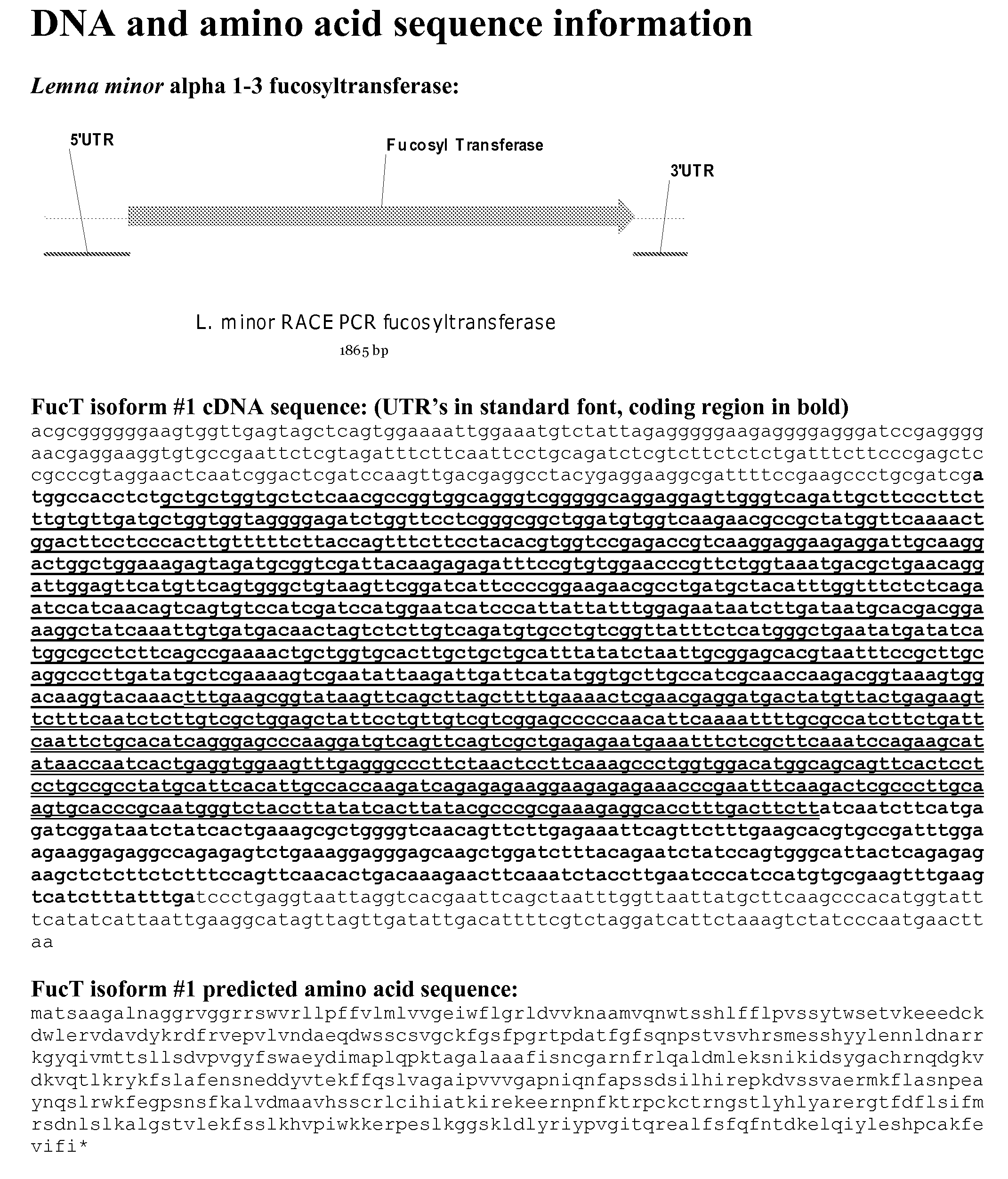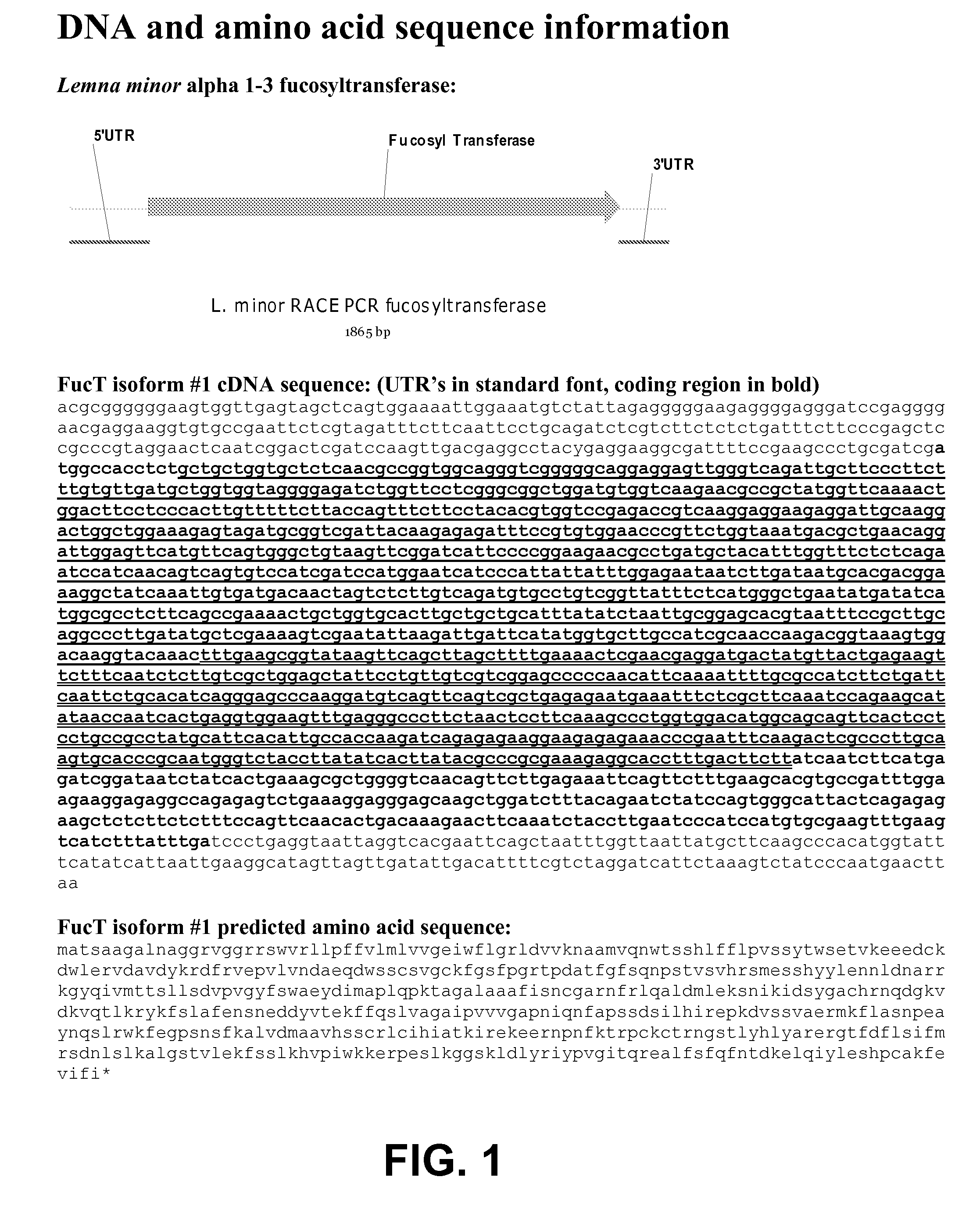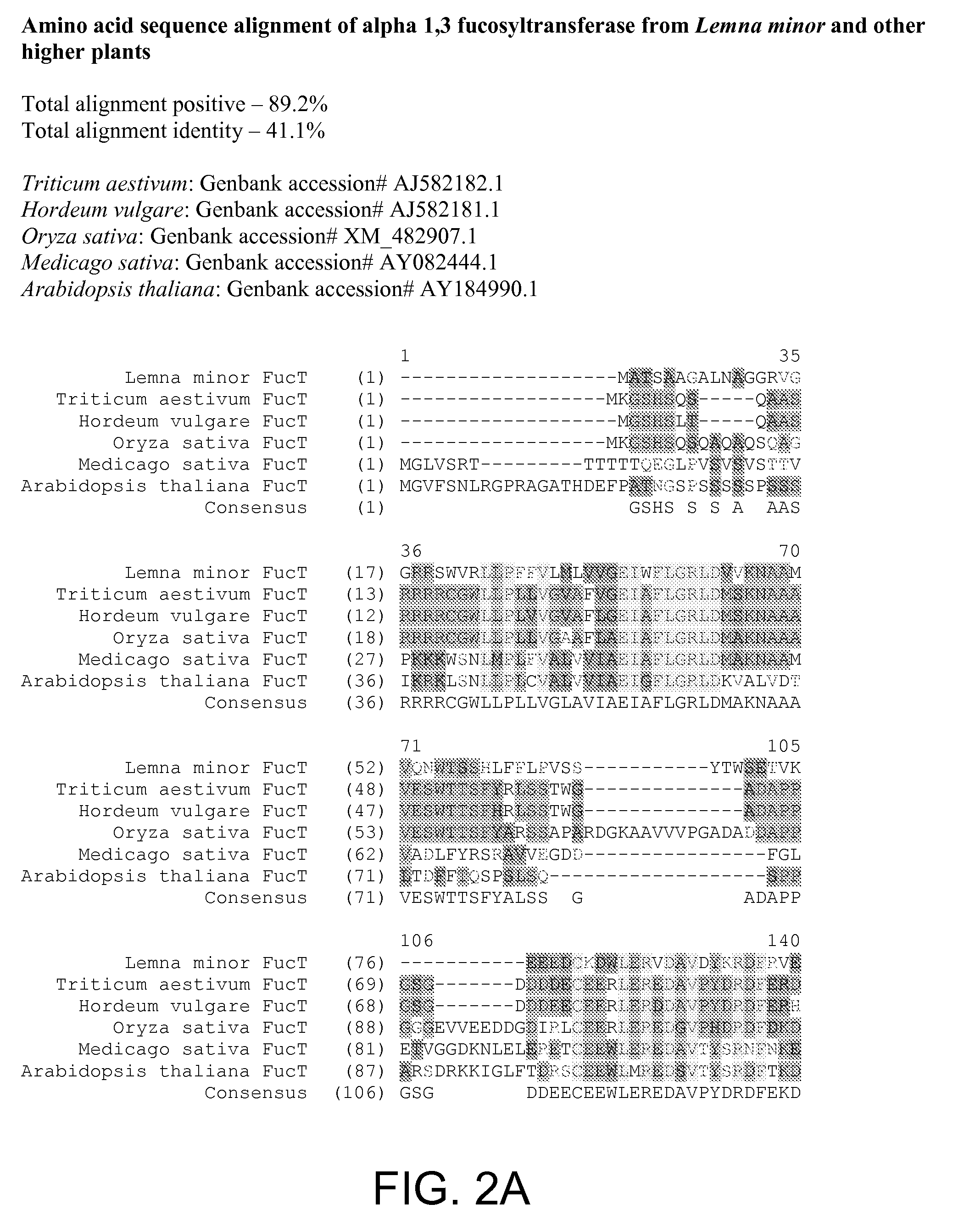Compositions and methods for humanization and optimization of n-glycans in plants
a technology of n-glycans and humanization, applied in the field of plant molecular biology, to achieve the effect of increasing the activity of adcc antibodies, increasing the function of effectors, and increasing the activity of n-glycans
- Summary
- Abstract
- Description
- Claims
- Application Information
AI Technical Summary
Benefits of technology
Problems solved by technology
Method used
Image
Examples
example 1
Isolation of Lemna minor Proteins Involved in N-Glycosylation of Proteins
[0320] In order to generate recombinant proteins with remodeled N-glycan, alpha 1-3 fucosyltransferase and β1-2 xylosyltransferase were selected as targets for RNAi gene silencing in L. minor. Initial results from cDNA sequencing efforts indicated that two or more isoforms were present for each of the target genes. Sequence homology between the isoforms was determined to be between 90% and 95%. Full length cDNA sequences for both target genes were retrieved and characterized. The full-length cDNA sequence, including 5′- and 3′-UTR, for L. minor α1-3 fucosyltransferase (FucT) is set forth in FIG. 1; see also SEQ ID NO:1 (open reading frame set forth in SEQ ID NO:2). The predicted amino acid sequence encoded thereby is set forth in SEQ ID NO:3. The encoded protein shares some similarity with other FucTs from other higher plants. See FIG. 2. For example, the L. minor FucT sequence shares approximately 50.1% seque...
example 2
RNAi Inhibition of Expression of L. minor FucT and XylT
[0322] Several RNAi strategies were undertaken to inhibit expression of the L. minor FucT and XylT isoforms. FIGS. 5-7, 33, and 34 outline these strategies. FIGS. 8-13 show maps of the various constructs that were made to achieve the desired knockout of expression of these two genes. A number of transgenic lines comprising the various knockout RNAi constructs were generated using standard transformation protocols described herein above.
[0323] The test antibody, designated herein as mAbI, was expressed in wild-type Lemna having the native glycosylation machinery, and transgenic Lemna lines expressing RNAi constructs designed to inhibit expression of L. minor XylT and FucT isoforms. Generally, three binary vectors were constructed for expression of mAbI in the Lemna system. Expression vector mAbI01 contained codon optimized genes encoding heavy (H) and light (L) chains of mAbI; vector mAbI04 contained codon optimized genes encod...
example 3
MALDI-TOF Assay for N-glycan β-1,2-xylosyltransferase (XylT) and α-1,3-fucosyltransferase (FucT) Activity
[0332] The following modified MALDI-TOF assay was used to determine XylT and FucT activity in the transgenic plants described in Example 2 above.
Materials
[0333] HOMOGENIZATION BUFFER: 50 mM HEPES, pH 7.5, 0.25 M sucrose, 2 mM EDTA, 1 mM DTT. [0334] REACTION BUFFER: 0.1 M Mes, pH 7.0, 10 mM MnCl2, 0.1% (v / v) Triton X-100. [0335] URIDINE-5′-DIPHOSPHO-D-XYLOSE (UDP-Xyl) [0336] GUANOSINE-5′-DIPHOSPHO-L-FUCOSE (GDP-Fuc) [0337] N-ACETYLGLUCOSAMINE [0338] POLYETHYLENE GLYCOL (PEG) MIXTURE 1000-3000 (10 mg / mL PEG 1000, 2000, and 3000 (4:5:6 ratio) mixed 4:1 with 2 mg / mL sodium iodide). [0339] [Glu1]-FIBRINOPEPTIDE B (GFP), HUMAN (1 pmol / μL in water) [0340] DABSYLATED, TETRAPEPTIDE, N-GLYCAN ACCEPTOR (EMD Biosciences) [0341] CHCA (α-CYANO-4-HYDROXYCINNAMIC ACID) MATRIX (10 mg in 50% [v / v] acetonitrile, 0.05% [v / v] trifluoroacetic acid).
Microsome Preparation
[0342]L. minor tissue (10...
PUM
| Property | Measurement | Unit |
|---|---|---|
| Tm | aaaaa | aaaaa |
| temperature | aaaaa | aaaaa |
| temperature | aaaaa | aaaaa |
Abstract
Description
Claims
Application Information
 Login to View More
Login to View More - R&D
- Intellectual Property
- Life Sciences
- Materials
- Tech Scout
- Unparalleled Data Quality
- Higher Quality Content
- 60% Fewer Hallucinations
Browse by: Latest US Patents, China's latest patents, Technical Efficacy Thesaurus, Application Domain, Technology Topic, Popular Technical Reports.
© 2025 PatSnap. All rights reserved.Legal|Privacy policy|Modern Slavery Act Transparency Statement|Sitemap|About US| Contact US: help@patsnap.com



